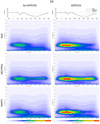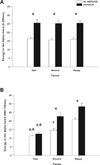Event-related oscillations to affective stimuli: heritability, linkage and relationship to externalizing disorders
- PMID: 22123122
- PMCID: PMC3264760
- DOI: 10.1016/j.jpsychires.2011.10.017
Event-related oscillations to affective stimuli: heritability, linkage and relationship to externalizing disorders
Abstract
Event-related oscillations (EROs) are heritable electrophysiological measures associated with cognitive activity and have been shown to be particularly informative for the genetic analysis of substance dependence and other psychiatric disorders. In the present study associations between the cortical event-related oscillations (EROs) elicited by affective stimuli, and the diagnosis of ASPD or CD (ASPD/CD) were investigated, and heritability and linkage analyses conducted in 662 individuals residing in an American Indian community. Results from this study found that participants with ASPD/CD showed increased alpha ERO energy in centro-parietal leads in the 0-250 ms time window in response to all three emotional expressions (sad, neutral and happy faces). Participants with ASPD/CD also showed increased alpha ERO energy in centro-parietal leads in the 400-700 ms time window in response to happy and neutral faces. Variance components analysis suggested a significant familial component to each of the described ERO phenotypes. Although a follow-up genome-wide linkage analysis failed to detect significant evidence of genetic linkage for any of these phenotypes, centro-parietal alpha energy in response to happy faces showed suggestive evidence of linkage to chromosome 1p36.31 (LOD = 2.40), in an area found in previous studies to be associated with externalizing phenotypes. Findings from this study suggest greater activation of neural circuits required to perform a facial recognition task in participants with ASPD/CD. The observed increase in alpha ERO energy may represent a heritable endophenotype associated with select externalizing disorders in this population.
Copyright © 2011 Elsevier Ltd. All rights reserved.
Conflict of interest statement
No conflict declared.
Figures


Similar articles
-
Event-related Oscillations to Emotional Faces are Related to a History of Internalizing Disorders.Clin EEG Neurosci. 2023 Jul;54(4):420-433. doi: 10.1177/15500594221088258. Epub 2022 Apr 4. Clin EEG Neurosci. 2023. PMID: 35379012 Free PMC article.
-
CR-19-0950: Event-related responses to alcohol-related stimuli in Mexican-American young adults: Relation to age, gender, comorbidity and "dark side" symptoms.Drug Alcohol Depend. 2019 Sep 1;202:76-86. doi: 10.1016/j.drugalcdep.2019.06.001. Epub 2019 Jul 6. Drug Alcohol Depend. 2019. PMID: 31323376 Free PMC article.
-
Event-related oscillations (ERO) and event-related potentials (ERP) in emotional face recognition.Int J Neurosci. 2008 Oct;118(10):1412-24. doi: 10.1080/00207450601047119. Int J Neurosci. 2008. PMID: 18788026 Clinical Trial.
-
Externalizing disorders in American Indians: comorbidity and a genome wide linkage analysis.Am J Med Genet B Neuropsychiatr Genet. 2008 Sep 5;147B(6):690-8. doi: 10.1002/ajmg.b.30666. Am J Med Genet B Neuropsychiatr Genet. 2008. PMID: 18286631 Free PMC article.
-
Neural Mechanisms Underlying Affective Theory of Mind in Violent Antisocial Personality Disorder and/or Schizophrenia.Schizophr Bull. 2017 Oct 21;43(6):1229-1239. doi: 10.1093/schbul/sbx012. Schizophr Bull. 2017. PMID: 28199713 Free PMC article.
Cited by
-
Event-related Oscillations to Emotional Faces are Related to a History of Internalizing Disorders.Clin EEG Neurosci. 2023 Jul;54(4):420-433. doi: 10.1177/15500594221088258. Epub 2022 Apr 4. Clin EEG Neurosci. 2023. PMID: 35379012 Free PMC article.
-
Low voltage alpha EEG phenotype is associated with reduced amplitudes of alpha event-related oscillations, increased cortical phase synchrony, and a low level of response to alcohol.Int J Psychophysiol. 2015 Oct;98(1):65-75. doi: 10.1016/j.ijpsycho.2015.07.002. Epub 2015 Jul 4. Int J Psychophysiol. 2015. PMID: 26151497 Free PMC article.
-
Delta Event-Related Oscillations Are Related to a History of Extreme Binge Drinking in Adolescence and Lifetime Suicide Risk.Behav Sci (Basel). 2020 Oct 7;10(10):154. doi: 10.3390/bs10100154. Behav Sci (Basel). 2020. PMID: 33036364 Free PMC article.
-
CR-19-0950: Event-related responses to alcohol-related stimuli in Mexican-American young adults: Relation to age, gender, comorbidity and "dark side" symptoms.Drug Alcohol Depend. 2019 Sep 1;202:76-86. doi: 10.1016/j.drugalcdep.2019.06.001. Epub 2019 Jul 6. Drug Alcohol Depend. 2019. PMID: 31323376 Free PMC article.
References
-
- Abecasis GR, Cherny SS, Cookson WO, Cardon LR. Merlin--rapid analysis of dense genetic maps using sparse gene flow trees. Nature Genetics. 2002;30:97–101. - PubMed
-
- Bauer LO, O'Connor S, Hesselbrock VM. Frontal P300 decrements in antisocial personality disorder. Alcoholism: Clinical and Experimental Research. 1994;18:1300–1305. - PubMed
-
- Bauer LO, Hesselbrock VM. Brain maturation and subtypes of conduct disorder: interactive effects on P300 amplitude and topography in male adolescents. Journal of the American Academy of Child and Adolescent Psychiatry. 2003;42:106–115. - PubMed
-
- Begleiter H, Porjesz B. Genetics of human brain oscillations. International Journal of Psychophysiology. 2006;60:162–171. - PubMed
Publication types
MeSH terms
Grants and funding
LinkOut - more resources
Full Text Sources
Molecular Biology Databases

